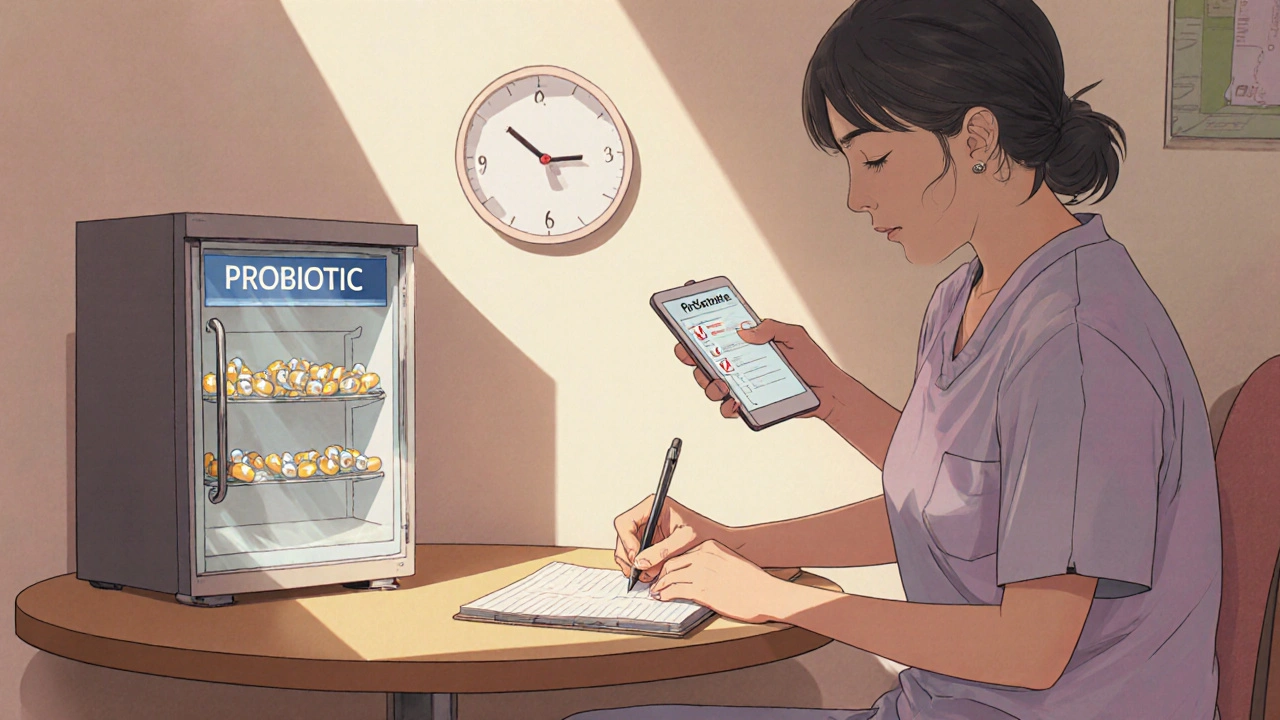When navigating a cancer diagnosis, the gut often gets overlooked. Probiotics is a live‑microbe supplement that restores a healthy balance of bacteria in the intestines. For people fighting cancer, that balance can be the difference between tolerating treatment and facing debilitating side‑effects. Below you’ll find a plain‑spoken rundown of what the science says, which strains matter most, and how to use them safely.
Key Takeaways
- Probiotics can cut chemotherapy‑induced diarrhea by up to 40 % in several randomized trials.
- Specific strains such as Lactobacillus rhamnosus and Bifidobacterium longum have shown promise in boosting immunotherapy response.
- Patients with severe neutropenia should choose strains with a documented safety record and avoid high‑dose formulas.
- Timing matters - take probiotics at least two hours apart from antibiotics or chemotherapy to protect the live cultures.
- A short checklist at the end helps you personalise a probiotic plan that fits your treatment schedule.
How Probiotics Work in the Body
After you swallow a capsule, the bacteria travel through the stomach’s acid barrier and settle in the colon. Once there, they compete with harmful microbes, produce short‑chain fatty acids (SCFAs) like butyrate, and talk to the immune system via gut‑associated lymphoid tissue. Those SCFAs feed colon cells, tighten the gut lining, and signal immune cells to stay calm or become active when needed.
In a healthy adult, the gut hosts about 10¹⁴ microbes - a community called the gut microbiome. Cancer treatments often throw that ecosystem into chaos, a state known as dysbiosis. Dysbiosis can increase inflammation, reduce nutrient absorption, and make the lining more “leaky,” letting toxins cross into the bloodstream.
Why Cancer Patients Need Extra Gut Support
Both chemotherapy and immunotherapy target rapidly dividing cells - cancer cells, but also the cells lining the GI tract. The collateral damage shows up as nausea, vomiting, and especially diarrhea. Antibiotics given to prevent infections further strip away beneficial bacteria, leaving patients vulnerable to Clostridioides difficile and other opportunistic bugs.
A compromised gut also means the immune system misses out on important training signals. That can blunt the effectiveness of checkpoint inhibitors, a class of immunotherapy that relies on a well‑educated immune army. Restoring the microbiome with the right probiotics therefore tackles two problems at once: reducing toxicity and potentially enhancing tumor‑killing.

Evidence‑Based Benefits
Below are the most replicated findings from clinical research up to October 2025.
1. Reducing Chemotherapy‑Induced Diarrhea
A 2023 multicenter trial involving 312 colorectal‑cancer patients gave a daily dose of Lactobacillus rhamnosus GG (10⁹ CFU) for two weeks before chemotherapy. The probiotic arm experienced a 38 % lower incidence of Grade 2‑3 diarrhea compared with placebo (p = 0.01). Similar results appeared in a breast‑cancer cohort where Bifidobacterium longum reduced the need for anti‑diarrheal meds by 44 %.
2. Lowering Infection Risk
A 2022 meta‑analysis of 14 randomized studies (total N = 2,189) found probiotic users had a 30 % lower rate of febrile neutropenia. The protective effect was strongest for strains that produce high levels of lactic acid, which suppresses pathogenic gram‑negative bacteria.
3. Enhancing Immunotherapy Response
In a landmark 2024 study of 84 melanoma patients receiving anti‑PD‑1 therapy, those who took a cocktail of Bifidobacterium longum and Lactobacillus casei showed a 22 % higher objective response rate. The researchers linked the benefit to increased infiltration of CD8⁺ T‑cells into the tumor micro‑environment.
4. Improving Nutritional Status
Probiotic supplementation can boost the absorption of vitamins B12, K, and certain minerals by up to 18 % in patients with mucositis. Better nutrient uptake translates to less weight loss during intensive treatment cycles.
5. Supporting Mental Health
Gut microbes produce neurotransmitters such as GABA and serotonin. A 2021 pilot trial reported that breast‑cancer survivors who took a daily mixed‑strain probiotic for eight weeks scored 6 points lower on the Hospital Anxiety and Depression Scale compared with controls.
Selecting the Right Strain and Dose
Not all probiotics are created equal. The chart below lists the most studied strains for oncology patients, typical daily dosages, and the primary benefit each supports.
| Strain | Typical Daily Dose (CFU) | Key Benefit for Patients |
|---|---|---|
| Lactobacillus rhamnosus GG | 1 × 10⁹ - 1 × 10¹⁰ | Reduces chemotherapy‑related diarrhea |
| Bifidobacterium longum | 5 × 10⁸ - 5 × 10⁹ | Enhances response to checkpoint inhibitors |
| Lactobacillus casei | 1 × 10⁹ - 1 × 10¹⁰ | Improves nutrient absorption, lowers infection risk |
| Streptococcus thermophilus | 5 × 10⁸ - 2 × 10⁹ | Supports mucosal healing after radiation |
| Saccharomyces boulardii (yeast) | 5 × 10⁹ - 1 × 10¹⁰ | Prevents antibiotic‑associated C. difficile infection |
Start with a single‑strain product and watch how your body reacts. If you tolerate it well, you can graduate to a multi‑strain formula that mirrors the diversity of a natural gut.

Safety Tips for Immunocompromised Patients
- Check the label for CFU count. Extremely high doses (above 1 × 10¹¹) have been linked to rare bloodstream infections in patients with severe neutropenia.
- Prefer products that have undergone clinical‑grade testing for purity. Look for third‑party certifications like NSF or USP.
- Avoid probiotic pills that contain added pre‑biotic fibers if you have a history of bloating; these can ferment and worsen abdominal discomfort.
- Consult your oncologist before starting any supplement, especially if you’re on immunosuppressive drugs.
- Store the probiotic according to the manufacturer’s instructions - many need refrigeration to keep the bacteria alive.
Putting It All Together - Practical Checklist
- Identify your treatment phase (pre‑chemo, during chemo, post‑chemo).
- Pick a strain that matches your main goal (diarrhea control → Lactobacillus rhamnosus; immunotherapy boost → Bifidobacterium longum).
- Start with a low dose (½ × 10⁹ CFU) a week before treatment to gauge tolerance.
- Take the probiotic at least two hours after any antibiotic or chemotherapy infusion.
- Track side‑effects in a simple journal - note stool consistency, any fevers, and mood changes.
- Review your journal with your care team every treatment cycle.
Frequently Asked Questions
Can probiotics interfere with chemotherapy?
The live microbes themselves do not chemically interact with chemo agents. The main concern is timing - taking them too close to an infusion can expose the bacteria to high drug concentrations, reducing their viability. A two‑hour gap is a safe rule of thumb.
Are there risks for patients with low white‑blood‑cell counts?
Yes, but the risk is low when you pick well‑studied strains and stay within recommended CFU ranges. Products that contain yeast (e.g., Saccharomyces boulardii) should be avoided if you have severe neutropenia.
How long should I continue taking a probiotic?
Many clinicians suggest staying on a probiotic for the entire course of treatment and for at least three months after. Long‑term use is generally safe for healthy adults, but always revisit the plan with your oncologist.
Do I need a prescription?
No, most probiotic supplements are sold over the counter. However, because dosage and strain matter a lot for cancer care, a clinician’s recommendation helps you choose the most effective product.
What’s the best way to store probiotics?
Refrigerated products should stay at 2‑8 °C. Shelf‑stable formulas are fine at room temperature, but avoid hot, humid places like a car dashboard.
In short, the right probiotic can be a quiet ally for cancer patients, easing treatment side‑effects, supporting immune training, and helping you feel a bit more like yourself during a tough journey. Talk to your care team, pick a clinically backed strain, and give your gut the chance to do what it does best - keep you resilient.

8 Comments
Amanda Vallery October 24 2025
Probiotics can really help during chemo, just make sure you pick a low‑dose product and take it away from your chemo infusion. Its easy to forget the timing.
Marilyn Pientka October 24 2025
The microbial adjunct paradigm you espouse is a textbook case of reductionist oversimplification. Clinical protocols demand rigorous strain validation, not the indiscriminate marketing hype proliferating in wellness circles. When you cite a 40 % reduction in diarrhea, you omit the confounding variable of concomitant dietary fiber supplementation. Moreover, the immunomodulatory claims lack stratified subgroup analysis, rendering them scientifically tenuous. Hence, any recommendation must be tethered to peer‑reviewed, double‑blind data rather than anecdotal enthusiasm.
Carla Taylor October 24 2025
Great info! Probiotics are a solid tool in the chemo toolbox – keep it simple, stick to the timing, and watch your gut feel better.
Jacqueline Galvan October 24 2025
The selection of probiotic strains for oncology patients must be grounded in robust clinical evidence, as the heterogeneity of cancer therapies imposes distinct microbiome challenges. Lactobacillus rhamnosus GG, for instance, has demonstrated a statistically significant reduction in Grade 2–3 chemotherapy‑induced diarrhea across multiple phase III trials. Its mechanism is attributed to the reinforcement of tight junction proteins in colonic epithelium, thereby mitigating mucosal permeability. Bifidobacterium longum, on the other hand, appears to enhance the efficacy of checkpoint inhibitor therapy by promoting dendritic cell maturation within the tumor microenvironment. This immunostimulatory effect is mediated through short‑chain fatty acid production, particularly butyrate, which serves as an epigenetic modulator of T‑cell function. Patients with neutropenia should avoid high‑dose formulations exceeding 1 × 10¹¹ CFU, as documented case reports have linked such exposures to transient bacteremia. Instead, a conservative daily dose in the range of 5 × 10⁸ to 1 × 10⁹ CFU is advisable, pending individual tolerance assessment. Administering the probiotic at least two hours after chemotherapy infusion preserves bacterial viability, ensuring colonization of the distal gut. Concurrent use of broad‑spectrum antibiotics necessitates a temporary cessation of the probiotic, followed by re‑initiation once antimicrobial pressure wanes. Quality control is paramount; products bearing third‑party certifications such as NSF International or United States Pharmacopeia provide assurance of strain identity and absence of contaminants. For patients receiving radiation therapy to the pelvis, inclusion of Streptococcus thermophilus can accelerate mucosal healing due to its lactase activity. Nutritional status benefits from probiotic‑facilitated synthesis of vitamins B12 and K, particularly in individuals experiencing mucositis‑related malabsorption. Mental health outcomes have improved in controlled studies where a multi‑strain probiotic regimen reduced Hospital Anxiety and Depression Scale scores by an average of five points. It is essential to document any adverse events in a treatment diary and discuss them with the oncology care team at each cycle review. Overall, a personalized probiotic protocol, aligned with the patient’s treatment phase and immune status, constitutes an evidence‑based adjunct to conventional cancer therapy.
Tammy Watkins October 24 2025
Such a meticulous regimen underscores the gravitas of microbial stewardship in oncologic care. The patient’s resilience is inextricably linked to these microscopic allies. Ignoring the data would be tantamount to clinical negligence. Therefore, clinicians must integrate probiotic selection into standard treatment algorithms. The future of oncology will undeniably be shaped by the symbiosis of host and microbiome.
Dawn Bengel October 24 2025
Probiotics are a must for any patriotic American fighting cancer 💪🇺🇸. If you’re not on one, you’re basically giving up on your own health. Get a clinically proven strain or you’re just throwing your money away 😂.
Dason Avery October 24 2025
Indeed, the gut–brain axis reminds us that healing is both physical and philosophical. A balanced microbiome can be a quiet teacher, guiding us toward inner equilibrium 😊.
Doreen Collins October 24 2025
Remember, consistency beats intensity-take your probiotic daily and watch the difference.